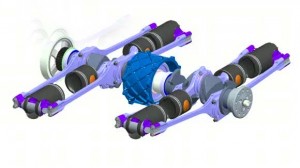Detroit-based powertrain company EcoMotors has landed a $200 million deal to produce its new opoc motor in China, a deal that initially will see the “breakthrough” engine design used for stationary generator applications – though the U.S. company’s chairman says off-road and commercial use, as well as automotive applications could follow.
Short for opposed piston-opposed cylinder, the opoc has generated significant interest in recent years because of compact size, low emissions and high efficiency. EcoMotors claims it can be as much as 50% more efficient than an advanced turbo-diesel, though the strategic agreement with Zhongding Power, based in Zuancheng, China, may be the real test to prove that advantage in the real world rather than a laboratory test bench.
Zhongding plans to begin producing its version of the opoc in 2014 and hopes to have capacity in place for up to 150,000 of the engines annually – projecting potential revenues of “over US $1 billion.”
“This agreement is a key milestone in bringing our innovative engine technology to market and underscores the potent disruptive force” EcoMotors claims the opoc engine can be, according to a statement from CEO Don Runkle.
The potential for the engine – some versions of which are small enough to carry in a briefcase – has drawn significant interest since EcoMotors began to go public several years ago. Among the key investors in the company are Microsoft founder Bill Gates and Silicon Valley’s legendary fund manager Vinod Khosla, of Khosla Ventures.
The basic design of EcoMotors’ engine, meanwhile, was developed by Peter Hofbauer, former head of powertrain development at Volkswagen AG. But the basic concept behind it dates back decades and a much less efficient version was once used by the Soviet military, among others.
The suburban Detroit firm has been negotiating deals with a number of possible customers, including one with the big truck maker Navistar that continues to move ahead, Runkle told TheDetroitBureau.com in an e-mail following the announcement of the Chinese deal.
But the strategic agreement with Zhongding could be the real breakthrough by putting the first version of the opoc into production by sometime next year. The initial application will be for “gensets,” the executive explained, or stationary generator, “then off-road, then commercial vehicles. We are also in discussions with them for a second smaller engine that would be applicable for pass(enger) cars. We also have three other customer LOI’s (not yet public), two of which are potential pass car applications.”
Runkle hinted three “U.S.-based companies” not yet identified are also exploring applications for the opoc.
With its high efficiency, low parts count and claimed ease of manufacturability, the new engine might seem a perfect fit in a world where the conventional internal combustion engine is facing tighter emissions and mileage standards around the world.
That said, EcoMotors still faces an uphill battle. There have been a number of potentially promising alternatives to the time-tested gasoline and diesel engines that dominate the auto industry today, including the Wankel, Stirling and two-stroke.
The Wankel, or rotary, recently went out of production when Mazda ended the run of the RX-8 sports car. An ambitious Australian firm, Orbital, set up a plant to produce its version of the rotary near Detroit around the turn of the Millennium, but that project never got underway and Chrysler eventually turned the facility into a conventional engine plant.
The Chinese deal could be the real test to see if opoc is ready to prime time.



I think the verdict is still out on this engine design’s actual merit but time will tell. Manufacturing in China is a poor choice IMO when the CEO and others are enjoying the trappings of the U.S.
Take a look at the videos of the PatOP prototype engine running on Diesel fuel, at http://www.pattakon.com/pattakonPatOP.htm
The PatOP is, just like the OPOC of EcoMotors, an opposed piston engine.
The full balanced single-cylinder two-opposed pistons PatOP basic-module has 50% fewer parts than the basic-module of the OPOC of EcoMotors which comprises two opposed-cylinders and four-opposed-pistons.
The PatOP can be more fuel-efficient than the OPOC of EcoMotors because it provides 20% additional time (longer piston dwell near the Combustion Dead Center) for the efficient combustion of the fuel.
The PatOP crosshead architecture enables “four stroke like” lubrication, lubricant consumption and emissions. In comparison EcoMotors’ OPOC burns a lot of lubricant, as the old 2-strokes, which means higher running cost and increased pollution.
Because of the lubrication / pollution issues of their engine, EcoMotors decided the first application of the OPOC to be in stationary power generator sets.
Talking for power generator sets,
the vibration-free quality of an OPOC power generator set (with 2 opposed cylinders, or with 22 opposed cylinder, or with 102 opposed cylinders) cannot compare with the vibration-free quality of a single cylinder OPRE power generator set because the basis of an OPRE engine driving two counter-rotating electric generators is not only perfectly rid of inertia vibrations (like a power set based on a Wankel rotary or on a V-12) but it is also perfectly rid of power-pulses vibrations of any kind (like a turbine).
This characteristic may seem “too much” for stationary power generator sets, but what about the REM (range extender module) for electric cars?
Videos of the OPRE prototype engine running on Diesel fuel are at http://www.pattakon.com/pattakonOPRE.htm
Scavenging.
A turbocharger can be used for the scavenging of the OPRE and of the PatOP opposed piston engines, just like in the OPOC.
Alternatively the PatOP and OPRE engines use the backside of the piston(s) to make a built-in zero-cost volumetric scavenging pump in order to eliminate the turbocharger of the OPOC. In this case the blade valves at http://www.pattakon.com/pattakonBlade.htm replace the conventional reed valves.
Thanks
Manousos Pattakos